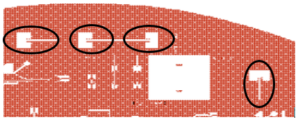This WP is dedicated to the design, the manufacture and the measurements of tunable microwave devices. The proposed demonstrators in this WP are based on the co-design method [1] developed at Lab-STICC allowing the design of microwave tunable devices without additional components. The devices are designed on a silicon substrate; thanks to the semiconductor properties some areas can be doped to obtain integrated semiconductor junctions allowing the commutation of the RF components. These devices, manufactured at GREMAN Tours, aim at being electrically controlled first, and then optically control too. This will be done in WP4.
The main tasks identified in this WP are the following:
- Modelling of the structures
- Synthesis of microwave reconfigurable devices
- Manufacture and measurements of electrically reconfigurable devices
The work in this WP mainly concerns two kind of devices: frequency reconfigurable resonators and a system of nested antennas.
Frequency reconfigurable resonator
The reconfigurable resonator is based on an LC structure [2]. The reconfiguration idea is to use the possibility of creating integrated short circuits at different points of the resonator. The short circuits are created using semi-conductors junctions directly integrated in the substrate through localized doped areas. Two states are basically possible: i) OFF state when the doped area is not polarized and then acts a open circuit between the transmission line and the ground plane; ii) ON state when the junction is polarized and then creates a short-circuit between the line and the ground. According to the state of the junction, the response of the resonator varies from an initial frequency to a reconfigured one, the frequency variation depending on the position of the doped area. Based on the same architecture, it is also possible to define resonators with multiple operating states.
The proposed concepts are not published yet, notably due to fabrication problems. A new run is under progress and more details will presented as soon as possible.
Nested antennas
Antennas for future communication systems will have to meet many standards for multiple applications. The antennas will have to be reconfigurable either in frequency to fit within the frequency specifications imposed by a standard or for a specific application, or in radiation pattern in order to radiate at different angles according to the need linked to the application. Reconfigurable antennas have for several years become a center of interest for engineers and researchers. Different works on reconfigurable antennas are developed on the basis of different technologies and different tunable elements, for example, PIN diodes [3], MEMS [4] or FET switches [5].
Here we present a new type of antennas that have been named nested antennas. It consists of patch antennas of different sizes that are nested one inside the other. The dissociation between each stage is done thanks to silicon doping [6]. Thanks to the establishment of rectangular borders and thanks to the doped zones, we create antennas nested in each other and relatively independent of each other.
Realization of first prototypes of single-stage doped antennas with a slot is in progress. Figure 3.2 shows part of the mask comprising these antennas. It will remain to measure them and to develop this idea even more.
Figure 3.2. A part of the mask containing our 1-stage doped antenna with slot
The proposed concepts not being published yet, they are not more detailed here for the moment.
[1] R. Allanic, Y. Quere, D. Le Berre, C. Quendo, “A novel approach to co-design microwave devices with distributed switches”, in IEEE Asia-Pacific Microwave Component (APMC), 2016.
[2] A. Saadi, M. Margalef-Rovira, Y. Amara, P. Ferrari, “Millimeter-wave Resonator Based on High Quality Factor Inductor and Capacitor based on Slow-Wave CPS”, in IEEE/MTT-S International Microwave Symposium, 2020.
[3] S. Nikolaou, et al, « Pattern and frequency reconfigurable annular slot antenna using PIN diodes » IEEE Transactions on Antennas and Propagation, 2006,Vol. 54, Issue 2
[4] R. Brown, Senior Member IEEE, « RF-MEMS Switches for Reconfigurable Integrated Circuits », IEEE Transactions On Microwave Theory And Techniques, 1998, Vol. 46, No: 11
[5] J. T. Aberle, S. Ohf, D. T. Auckland, and S. D. Rogers ? « Reconfigurable Antennas for Portable Wireless Devices », IEEE Antennas and Propagation Magazine, Vol. 45, No. 6, December 2003
[6] R. Allanic, D. Le Berre, Y. Quéré, C. Quendo, D. Chouteau, V. Grimal, D. Valente, J. Billoué, « A Fully Integrated Frequency Reconfigurable Antenna Co-designed as a Whole Circuit on Silicon », Proceedings of 2018 Asia-Pacific Microwave Conference


